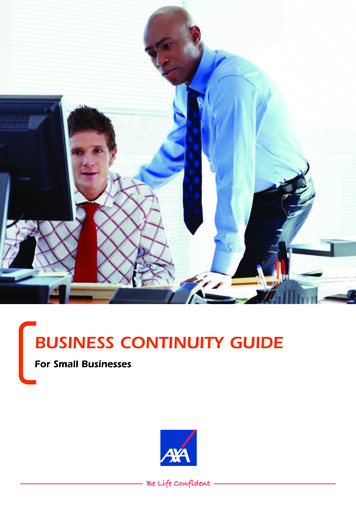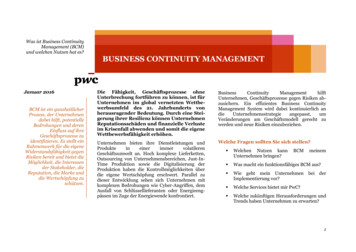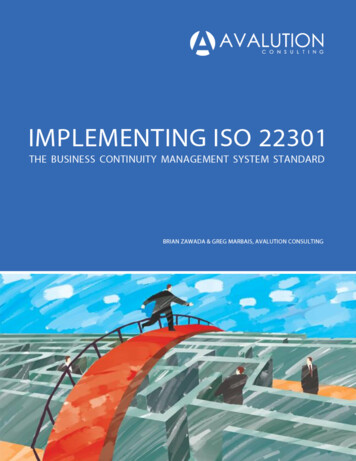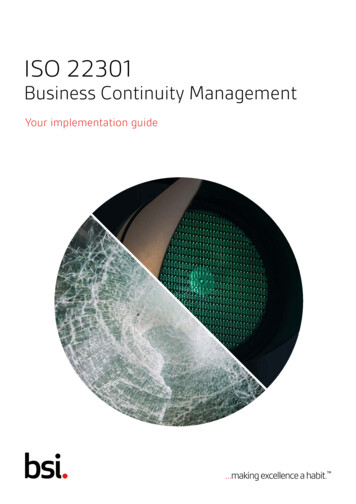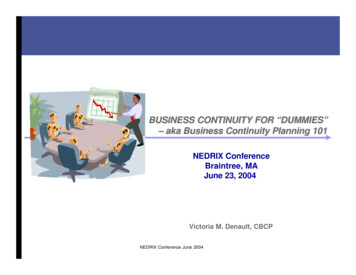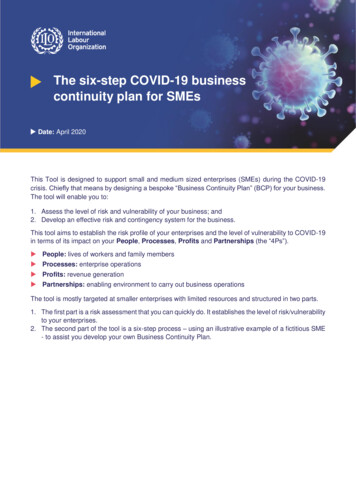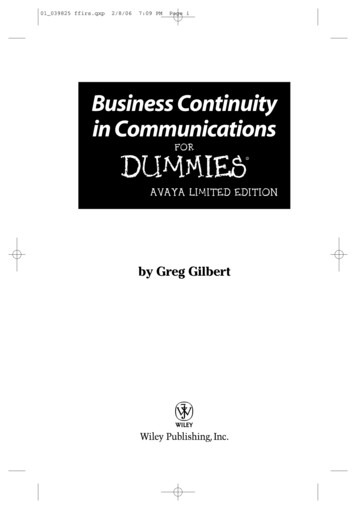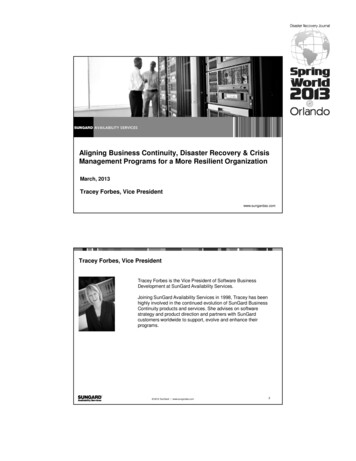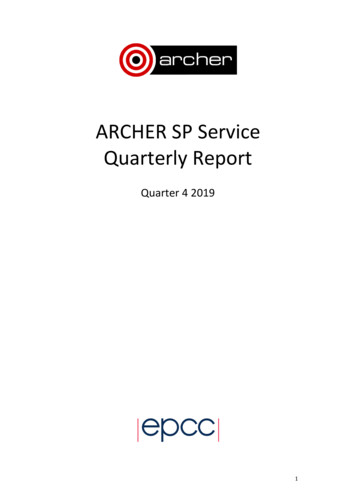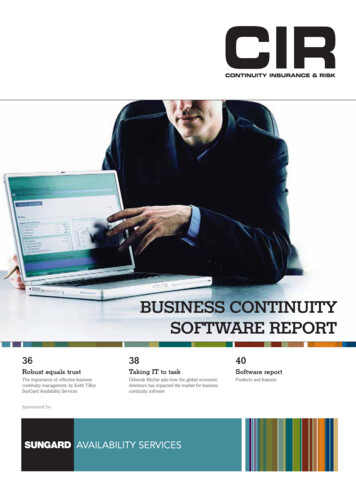
Transcription
BUSINESS CONTINUITYSOFTWARE REPORT363840Robust equals trustTaking IT to taskSoftware reportThe importance of effective businesscontinuity management, by Keith TilleySunGard Availability ServicesDeborah Ritchie asks how the global economicdownturn has impacted the market for businesscontinuity softwareProducts and featuresSponsored byAVAILABILITY SERVICES
dardised reportingcesscure aclised secentrastancy manedndepeingppnconsistedata ccessesorpdateautomyAVAILABILITY SERVICESKeep your business continuity plans movingAs your business continuity strategy grows – particularly if you have numerous plans across multiple sites – therecomes a point when standard office software doesn’t have the dynamic manageability you need to maintaincontrol. At this point, moving to a solution that is purpose-built becomes the only realistic way you can ensure allyour plans stay up to date.With SunGard Availability Services Continuity Management Solution (CMS) you can select a software package thatsuits your needs – there are six to choose from. Enabling you to update your business continuity strategies in realtime and with complete accuracy at all times.Gain an insight into all your CMS options with an engaging online clip at:www.sungardcms.co.ukSunGard and the SunGard logo are trademarks or registered trademarks of SunGard Data Systems Inc. or its subsidiaries in the U.S. and other countries.All other trade names are trademarks or registered trademarks of their respective holders.
BUSINESS CONTINUITY SOFTWARE REPORT OPINIONAVAILABILITY SERVICESCONTINUITY MANAGEMENT SOLUTION (CMS)Robust equals trustThe importance of effective business continuity managementToday’sorganisationsare complexstructures. Even thesmallest of companies have todeal with an intertwined web ofsuppliers, customers, partners andemployees spread across a varietyof different locations – oftenglobally. Increased levels ofoutsourcing also mean that noncore and sometimes even coreprocesses are entrusted to thirdparties. At the same time, modernorganisations are continuallyevolving to offer new productsand move into new markets, oftenwithin a very short timeframe.In the new world of on demandservices where customers expectbusinesses to be fully operational24/7, businesses cannot afford tobe offline even for a few hours.Just five years ago the averageorganisation would be able to copewith recovering 30 to 40 per cent oftheir business after an outage, buttoday, expectations are set to risethanks to new technologicaldevelopments which means it’sperfectly viable for 60 to 70 percent of staff to be recovered withina shorter timeframe.Doing their best to keep this webintact is the business continuity(BC) manager, on whose shouldersis placed the huge responsibility ofensuring that if something does gowrong, plans are in place to cope.The need for a multi-facetedbusiness continuity management(BCM) process that remains fluidand constantly evolving is thereforeperhaps more important now thanever before.Keeping plans live to surviveThough demands on the BCmanager are increasing, thankfully,technology and services which36 CIR August 2010engender continuity and availabilityare becoming more advanced, andat the same time, are now muchmore affordable than only a fewyears ago. For example, wewill soon be offering a servicebased on virtualisation technologywhich enables organisations torecover a far greater proportionof their staff by providing accessto recovered data and systemswherever they have access toa PC, internet connectionand telephone.While these continuous advancesin business and ICT availability areultimately of huge benefit toorganisations of all sizes, eachadvance requires a change to theexisting or corresponding BCplan(s). Consequently, a BCplan can no longer be a staticdocument that may or may notbe updated every once or twicea year. It needs to be fluid,constantly evolving, dynamicmanagement process that takesinto consideration changes incircumstances, regulations,technology and people.Organisations need a ‘living’ planthey can trust, that integratesseamlessly with the business,yet can be easily modified to“Keeping this webintact is the businesscontinuity manager,on whose shouldersis placed the hugeresponsibility ofensuring that ifsomething does gowrong, plans arein place to cope”accommodate the evolving needsof people and processes. And itis not just important from aninternal perspective – customers,shareholders and regulatorybodies often demand thatorganisations have processes inplace to ensure recovery fromany disruption to operations.Unfortunately, as many BCmanagers will know, keepinga BCM process current andrelevant is an incredible burden,not least because a lot of time isspent on the maintenance of plansand a struggle with templates thatwere not specifically developed tothe needs of the BC manager.Effective, tailored, BCM softwarecan make a huge difference: it canhighlight problem areas in thebusiness and help with assessmentsaround various areas of riskincluding supply chain and theworkforce. It also frees up time forthe BC managers to focus on theprimary task of protecting thebusiness, but also the task ofmarketing the value of businessresilience to customers andstakeholders and positioning itas a key differentiator.Beyond Word and ExcelMany companies still use MicrosoftOffice software to house andmaintain continuity plans, butthis approach generally can’t meetthe stringent requirements forupdating and maintaining plans.BCM processes need to beunderpinned by documents andresources that truly reflect ongoingchanges in the organisations theyserve. Real-time revisions arebest maintained in a relationaldatabase with BCM softwaredesigned specifically to performchanges and automate the entireplanning process. In addition to awww.cirmagazine.com
BUSINESS CONTINUITY SOFTWARE REPORT OPINIONAVAILABILITY SERVICESCONTINUITY MANAGEMENT SOLUTION (CMS)relational database, BCM softwareprovides: the flexibility to customiseto the requirements of companystandards, simplicity for the plandevelopment process to integratewith multiple plans and increasedefficiency for plan maintenanceand activation.Aside from saving hours ofword processing time, the best BCMsoftware can now cover businessimpact analyses, continuity planning,incident response and emergencynotification on a common, easy-to-use,web-enabled platform.One particularly important aspectthe latest BCM software can help withis workforce assessment. Whether thesituation involves the major loss of afacility, the failure of a criticalbusiness operation or a widespreadevent such as a pandemic, the rightBCM software can help evaluatecritical personnel’s ability to respondto disruptions. With the best softwarefor workforce assessment, a companycan answer the following and manyother questions: Who has a critical recovery role?Are there situations for these criticalemployees that would impede theirability to support the organisationduring a disaster?Who has BC experience?Who has taken part in a test,and what was their role? How prepared are our staffto work at home? Do they havethe right equipment, workenvironment, and securityto protect company assets? How dependent are weon contractors or consultants?How critical are they to companyoperations? Will they be ableor willing to participate in arecovery event? How current is the information wehave on our workforce: contactnumbers emergency contactinformation, skills and rs and otherthird parties expectbusiness continuityprocesses to be inplace and it maywell be a conditionof doing businesswith them”The same applies to vendorcapabilities: with the supply, or value,chain having become critical to theoperation with straight through orseamless processes betweencustomers and vendors. Theseprocesses are now at far greater riskof disruption due to the lengtheningof these chains. So it is no longeracceptable to simply trust a vendorwill be reliable during a disruptionyou need to know they can surviveand supply your business. The latestdevelopments in BCM software canhelp evaluate service providers’ orsuppliers’ compliance with theorganisation’s own continuityrequirements through vendorassessment. Effective assessment: Minimises vendor recordmaintenance and enables vendors toverify and update information online,including contract information.Minimises weaknesses in thesupply chain by identifying servicesor suppliers not in compliance. Collects and stores vendorcontracts centrally; identifyingvendors with low resilienceand risk.Making the right choice for youThe latest developments in BCMsoftware will be of most interest totwo types of organisations: larger,more complex organisations whowant to improve their BCM planning,and smaller organisations thatare only just embarking on theprocess and want to get it right atthe first opportunity.Many of the former will havemultiple plans and facilities thatspan across a number of differentcountries, a complex businessnetwork, and employ workers thatare not based in one specificlocation. A standard MS Officeplan will be too time-intensive tokeep up, lack the inbuilt relationalcapabilities to be truly fit for BCMpurpose, and will not leave the BCmanager time to be strategic andkeep up with all the changes in thebusiness and its environment.For smaller organisations orthose new to adopting BCM, it isimportant to get it right the firsttime. This is an age where BCprocesses are increasinglyexpected and seen as vital.Customers, suppliers and otherthird parties expect such acapability to be in place and it maywell be a condition of doingbusiness with them. For start-upsit is important to remember that aDIY approach to BCM is a falseeconomy, ultimately costing moretime, efficiency and money in thelong run.Whatever your shape oforganisation, when selecting thetools to underpin your continuityand availability processes, it isimportant to select those that aretruly up to the task at hand.That is why BCM software is abetter choice than office software.And why when you take the BCMsoftware route – a proven,reputable, well-established solutionwhich is also in tune with the latestgood practice requirements isbetter still.Then your partners, suppliers,customers and stakeholders canbe assured that you’ve done all thatis reasonable to prevent lettingthem down.Keith Tilley is managing director,UK and executive vice-presidentEurope for SunGard AvailabilityServicesCIR August 2010 37
BUSINESS CONTINUITY SOFTWARE REPORT INTRODUCTIONAVAILABILITY SERVICESCONTINUITY MANAGEMENT SOLUTION (CMS)Taking IT to taskDeborah Ritchie asks how the global economic downturn has impacted themarket for business continuity softwareBy the beginning of thisyear, the global economicdownturn had taken a tollon business continuity (BC) teamsand smaller vendors in the UK andoverseas, resulting in a handful ofclosures, in some cases layoffs andat least cutbacks in others.Naturally, this trend extended intothe BC software market.CEO of US-based BC softwareprovider Coop Systems, ChrisAlvord, who has been in thebusiness for almost ten years,believes the IT aspect of the BCoperation took much of the hitfollowing the downturn, but thatbusiness has picked up sharplysince Autumn 2009 whenhe said capital spending droppedby about 50 per cent in thesecond quarter.“Other sectors, which werenot as exposed to the sub-primemortgage crisis were obviously notas directly affected, and in matureoperations where the BC reports torisk department, funding haslargely been retained. Some fortyper cent of our business this yearwill come from the finance sector,”he adds.Business continuity softwareprovider, Paradigm SolutionsInternational president and CEO,Raymond Huger, offers his view:“Some of the projects that we hadlined up didn’t happen, becauseeveryone was taking a wait-and-seeattitude. This year, however, thingsare moving along. There’s a lotmore activity.”It’s no surprise that in difficulttimes, the value of any investmentcomes under much greater scrutiny.As Simon Maddox, director,solution design and support, ICMContinuity Consulting, points out:38 CIR August 2010“It sometimes takes a downturn forpeople to be more careful with theiroverheads. There is no point havinga tool unless it is adding real value.“I have seen some smallerorganisations say they don’t evenwant to look at BC at the momentas it is seen as a risk they areprepared to take in the recession;it becomes an acceptable riskgiven the other pressures.”Ramesh Warrier, director ofCanadian firm, eBRP Solutions,observes: “Most business executiveshave been trying to trying to ensurethat their company financials lookgood, so that they are seen to havespent less and spent only on whatthey need to spend on. They arefocusing on their core competenciesand outsourcing those functionsthat are not.”On the other hand, there areother firms that, having tightenedtheir belts already, have become sodependent on the smooth runningat all times of the rest of thebusiness that the risk assessmentprocess is even more heightened.“It comes down to value. You canjustify the spend when it can returnadvantages that you can’t getelsewhere,” says Maddox.Tracey Forbes, vice-president,product development, SunGardAvailability Services concurs:“The global economic downturnhas required organisations to domore with less so the time savingsprovided by BC managementsoftware are very valuable.”Carrying out a BIA on aglobal enterprise with 100,000 employees, for instance, is a jobparticularly well suited to some ofthe BC software products on themarket today, Maddox points out.Hamburg-based vendor MathiasRosenberg disagrees with theseviews on the economic picture.“I don’t think our business hasbeen affected by the downturn. Weare actually doing better business.”His firm, Controll IT’s latest projectinvolves the development of adisaster recovery testing function toenable larger customers (includingone major German bank) to easilyplan tests and then follow them inreal time.But one thing is for certain in thiseconomic environment, and that’schange. In terms of BCmanagement itself, re-prioritisationis the order of the day, which hasprovided fresh impetus fordeveloping new functionality.New prioritiesOver the last year or so themarket has moved beyondbusinesses being worried abouttheir own continuity capabilitiesalone to considering more closelythose of their supply chain. Newfunctionality like SunGard’sContinuity Management Solution’s(CMS) Vendor Assessment toolcan make this task far easier tocarry out.In addition to the supply chain,organisations are now looking forways to cut costs by removing anysurplus. “Newer technologies suchas our Notifind technology whichautomates the ‘roll-call’ exercisesinvolved during any major incidentwhere staff need to be contactedcan also help simplify the plansthemselves and remove layersof process and detail,” saysSunGard’s Forbes.“Customers want greater realtime recovery capabilities,” addsAlvord. COOP’s latest offering alsoincludes a notification function,www.cirmagazine.com
BUSINESS CONTINUITY SOFTWARE REPORT INTRODUCTIONAVAILABILITY SERVICESCONTINUITY MANAGEMENT SOLUTION (CMS)provided in conjunction with MIR3.Alvord’s team has also been focusingon adding more advanced relationaldatabases to its product’sfunctionality, a significant step toadding more analytical and visualpower to the offering. Last is a newability to make all planning contentaccessible securely through eightmajor types of mobile devices.eBRP’s Warrier, whose clientsinclude a glut of Fortune 500Enterprises and many large financialinstitutions, and whose product isbuilt to be ITIL compliant, says,“We have improved our productin terms of incident management –that is command, control andcommunications.”Over the last year, many of themajor software providers have beenfine tuning their products to includethese instant messaging features andother new functions and technologiessuch as enhanced BIA functions andautomatic RTO calculations.Huger points out that these newfunctions can have a dual purpose ifused correctly. Of their instantmessaging function, he says, “Thiscan also be used on a day-to-daybasis, when you are developing theplans together. It’s a usefulcollaborative feature that can alsolend itself to a crisis situation.Paradigm’s OpsPlanner solutionis also looking to add enhancedlanguage capabilities and multi-smartphone functionality, and ICM is soonto release its new iPhone app.“A lot has changed, Maddoxexplains. “I started out in thebusiness in 2001 when we developedthe first web-based BC tool. Usingemail reminders was quite ahead ofthe game. What I am seeing now isthe move from plans being fixed tothe desktop, to having them more inpeoples’ hands.”That mobile capability is, hebelieves, the most significant strategicshift. “ICM has also developed aBlackBerry application which is notdependent on a connection, butwhich synchronises to the applicationwhen it can. This to me is only thestart of things.”Taking business-critical plans tothe mobile level will bring homethe security imperative, however.One could hardly call the iPhoneFort Knox, and now the security ofthe long trusted BlackBerry maybe in question – at least by theUAE and possibly now the IndianGovernment, too.But security fears are not stemmingthe tide in mobile platformdevelopment. Stateside, GeorgeLiscinsky, senior vice president atRecoveryPlanner, which is about tobring its RPX Mobile to market isconfident about the outlook. “We’vehad a very brisk summer businesswise. The summer months areusually quieter, but we believeour clients consider BCM evenmore important if they have cutback on personnel. Saving timeand resources is exactly what wepromote with our software.They are currently addingnew language and compliancefunctionality that aims to helpclients align their plans withpertinent regulations. “We’rereally excited about our recentenhancements to our integratedincident management andnotification system.”Factoring in Liscinsky’s positiveoutlook is his theory that themarket is not yet broken in the US.“There are a lot of companies outthere without BCM programme,”he smiles.Just seven months after wewelcomed in a very unhappy newyear, the picture looks brighteralready, with business looking upacross all sectors throughout theUK and beyond.So while this year may have gotoff to a slow start for the IT market,for some, it is just the beginning.
BUSINESS CONTINUITY SOFTWARE REPORT PRODUCTSBusiness continuitysoftware reportYour guide to business continuitymanagement softwareAVAILABILITY SERVICESCONTINUITY MANAGEMENT SOLUTION (CMS)40 CIR August 2010SUNGARD CONTINUITYMANAGEMENT SOLUTIONSUNGARD AVAILABILITY SERVICESFunction: SunGard’s CMS is acomprehensive solution designed tomanage all phases of the businesscontinuity management (BCM) lifecycleand advances in recovery technology andtechniques such as the virtualisedrecovery desktop and soft phones. Assuch, the solution now encompasses newworkforce and vendor assessment tools.Launched: 1988, continuous developmentsince. Additional modules were releasedin 2010 covering risk assessment,workforce assessment, and vendor (supplychain) assessment.This product is typically aimed at multi-siteand large-scale organisations looking toimprove their business resilience by usingsoftware to help them manage and automatethe complexity arising from multiple plansacross multiple sites. This helps to improveresilience without increasing headcount.The product is aimed at both the publicand private sectors. SunGard’s CMS is alsosuitable for those organisations thatoriginally developed their plans in MSOffice but now find that business growthand constant change means that MS Officebased plans are no longer suitable to useas the relational data and Macros nowembedded in the plan need constantattention and upkeep.SunGard’s CMS allow users to developcall lists as easily as they can open, movefiles, and map dependencies. This al
BUSINESS CONTINUITY SOFTWARE REPORT 36 Robust equals trust The importance of effective business continuity management, by Keith Tilley SunGard Availability Services 38 Taking IT to task Deborah Ritchie asks how the global economic downturn has impacted the market for business continu
